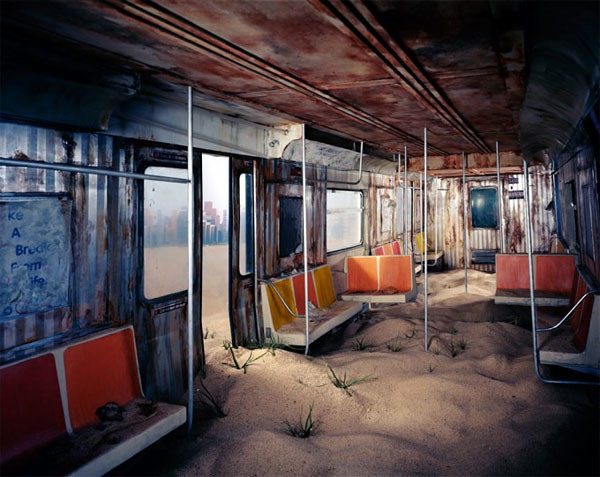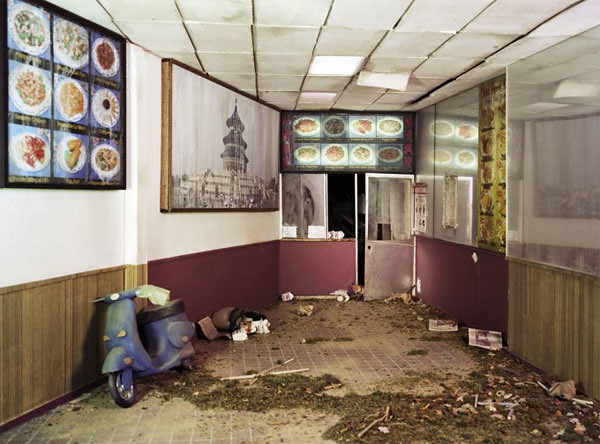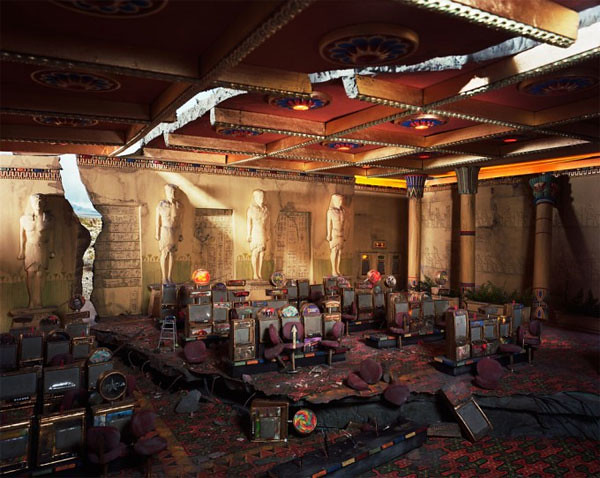
"Subway," Lori Nix, All rights reserved
While never completely out of fashion, apocalyptic fantasy art was once the realm of disillusioned outsiders. No longer. Baying forth directly from the deep pockets of corporate high tech, today’s sleek, dystopian movies, TV, video games and other visual media now dominate our imaginative culture. At the same time apocalypse-themed fiction and nonfiction books and journalism drive much of our intellectual discourse. No civilization has ever been more thrilled by its own demise.
Photographer Lori Nix’s end-of-the-world show, “The City,” at Clampart covers this familiar territory but not without staking out its own brand of modesty and wit. A self-proclaimed “danger and disaster” artist, Nix admits to being “fascinated, maybe even a little obsessed, with the idea of the apocalypse.” Her show imagines a New York City in which all humans have been suddenly terminated, leaving behind only their objects and buildings. This “post-human” metropolis is depicted in large color prints of iconic public spaces — a library, a shoe store, a Chinese take-out restaurant, etc.
The verisimilitude of the little worlds is remarkable. But Nix’s miniature power tools are, after all, not CGI and her old-school archival color printing is not Photoshop. Her interiors are sometimes flawed. Not often, and not by much, but enough so a close viewer will notice. For instance, the show’s advertising shot, a cunningly realistic B subway train, forever stalled and filling up with sand at the Brooklyn end of the Manhattan Bridge, looks across a sand-locked East River to a rudimentary stage-set drawing of the Manhattan skyline. Why not make the skyline look as real as everything else?

"Chinese Take-Out," Lori Nix, All rights reserved
I’m guessing Nix wants her pictures to inspire awe and unease at a distance and then––as the viewer takes a closer, more leisurely view––provide pleasure and a few chuckles. Her “Chinese Take-Out” picture, for example, brilliantly conjures the formulaic elements of such places – basic store front décor, a picture of ancient temple from the old country, standard OSHA “First aid for choking” poster and two sets of what-you-see-you-get food photos of General Tso’s Chicken, Vegetable Lo Mein and other dishes, identified in Mandarin and English. The fabricators have taken great pains to “distress” the interior with dirt and grime and to strew around red-stamp-labeled take-out containers and authentic-looking pages from a tiny New York Times. But when Nix places a blue delivery scooter right at the front of the room, it’s impossible to miss that it’s a child’s toy. And, look, what’s that sneaking through the open kitchen door? It’s a stuffed red fox. Should I be surprised when a quick Google search reveals that – according to Chinese tradition — the fox is a signal from the spirits of the dead?

"Casino," Lori Nix, All rights reserved
I don’t think so. After scheming and tinkering for over half a year on these pint-sized replicas, I imagine very little – if anything – has been missed. What’s more, the playfulness turns up in the other pictures, too. For instance, in “Space Center,” imagined as a once proud, now desolate museum of human flight, two hawks are busily nesting in what’s left of a Mars Rover. In “Casino,” the ceiling is torn open like a tomb to reveal cheesy replicas of dynastic Egyptian guardian statues standing against walls covered with hieroglyphics. The floor is filled with rusting slot machines that bear names like “Strike It Rich.” One of them is called “Doomsday.”
I’m glad that Lori Nix is making pictures of disaster we can really look at. With its low-tech craft and slow-dawning gags her work feels personal – to her and to us. We are invited into a very still, and sad — and undeniably ridiculous — made-up world. It occurs to me this may be a better place to contemplate human folly than shoulder to shoulder with a movie star as he mows down zombies.
Originally published in The New York Photo Review
No comments:
Post a Comment